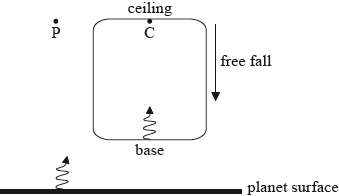| Date | May 2014 | Marks available | 2 | Reference code | 14M.3.HL.TZ2.17 |
| Level | Higher level | Paper | Paper 3 | Time zone | Time zone 2 |
| Command term | Describe | Question number | 17 | Adapted from | N/A |
Question
This question is about general relativity.
The diagram shows monochromatic light of frequency \({f_0}\) being emitted from the base of a box towards an observer C at the ceiling of the box. The box is in free fall above the surface of the planet. Light of the same frequency is also emitted from the surface of the planet towards an observer P at rest above the surface of the planet.

The frequency of the light as measured by C is \({f_{\text{C}}}\) and the frequency of the light as measured by P is \({f_{\text{P}}}\).
State and explain whether the frequencies \({f_{\text{C}}}\) and \({f_{\text{P}}}\) are less than, equal to or greater than \({f_0}\).
(i) \({f_{\text{C}}}\)
(ii) \({f_{\text{P}}}\)
Newton explained the motion of a planet around the Sun in terms of a force of gravitation between the Sun and the planet. Describe how Einstein’s theory of general relativity explains the motion of the planet around the Sun.
Markscheme
(i) the box is equivalent to an inertial frame of reference (far from any masses);
so \({f_{\text{C}}} = {f_0}\);
(ii) the energy of a photon is \(h{f_{\text{P}}}\);
light loses energy as it rises;
so \({f_{\text{P}}} < {f_0}\);
or
P’s frame of reference is equivalent to a frame accelerating upwards (far from any masses);
P moves away from the emitted light / the “space” between P and original source increases;
so (by the Doppler effect) \({f_{\text{P}}} < {f_0}\);
the mass of the Sun bends the spacetime around it;
particles follow paths of least length/geodesics (when no forces act on them);
paths of least length/geodesics are curves in the bent spacetime;
Examiners report
The equivalence principle was usually stated, but not always in unambiguous terms. In (b) the two situations were often confused. Candidates were less sure of the frequency in the free fall situation and usually did not recognise the box as an inertial frame. Many were able to explain why the frequency received by P was less than \({f_0}\). Most were able to refer to the sun 'bending' spacetime. Fewer referred to geodesics or the fact that they corresponded to the circular/elliptical orbit of a planet.
The equivalence principle was usually stated, but not always in unambiguous terms. In (b) the two situations were often confused. Candidates were less sure of the frequency in the free fall situation and usually did not recognise the box as an inertial frame. Many were able to explain why the frequency received by P was less than \({f_0}\). Most were able to refer to the sun 'bending' spacetime. Fewer referred to geodesics or the fact that they corresponded to the circular/elliptical orbit of a planet.

